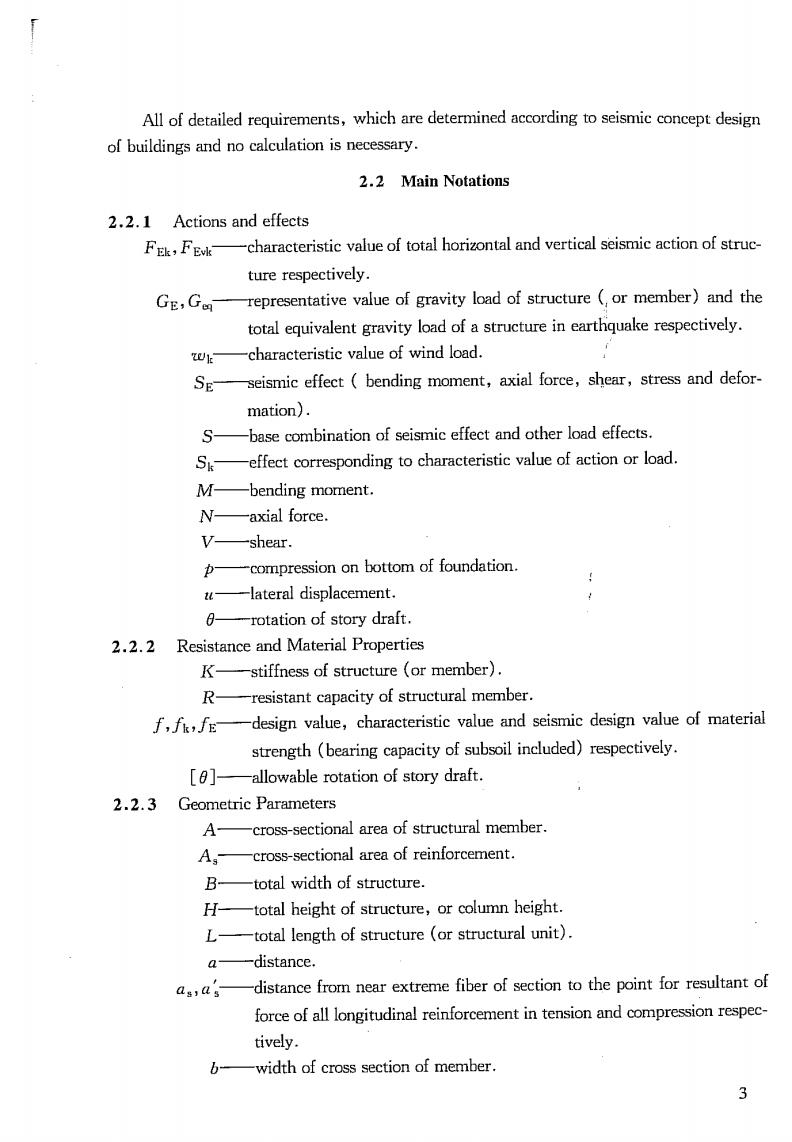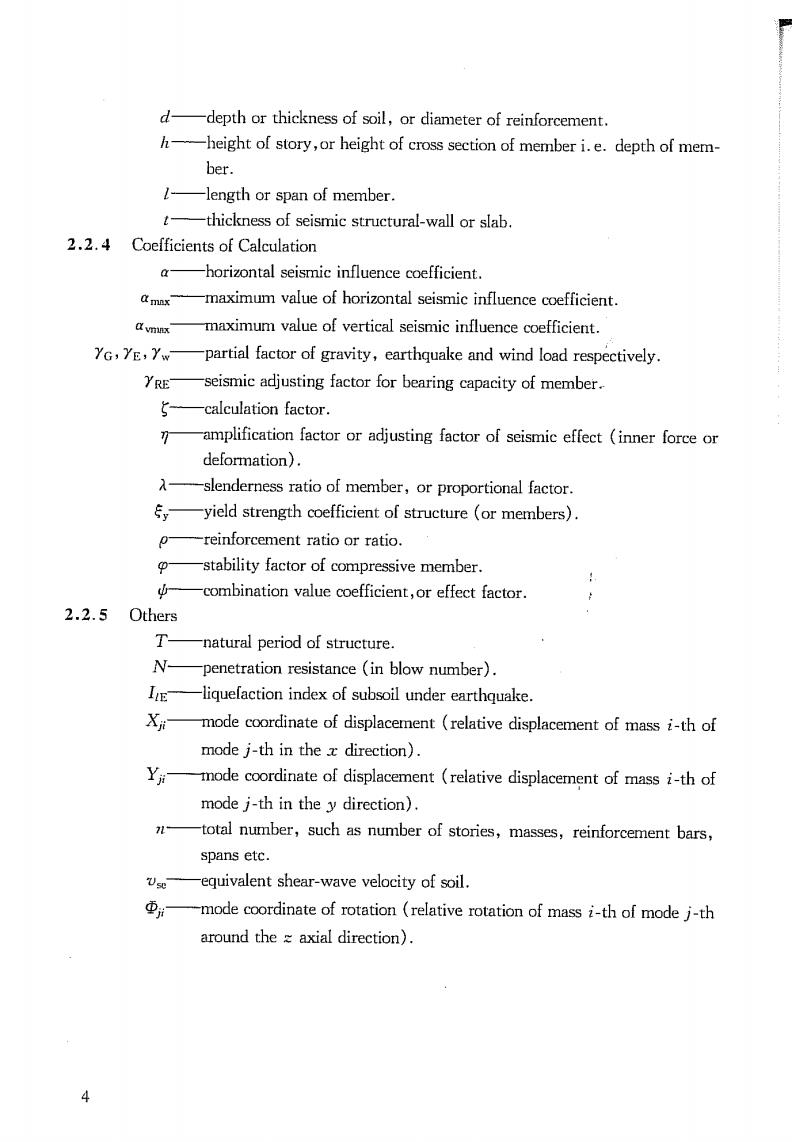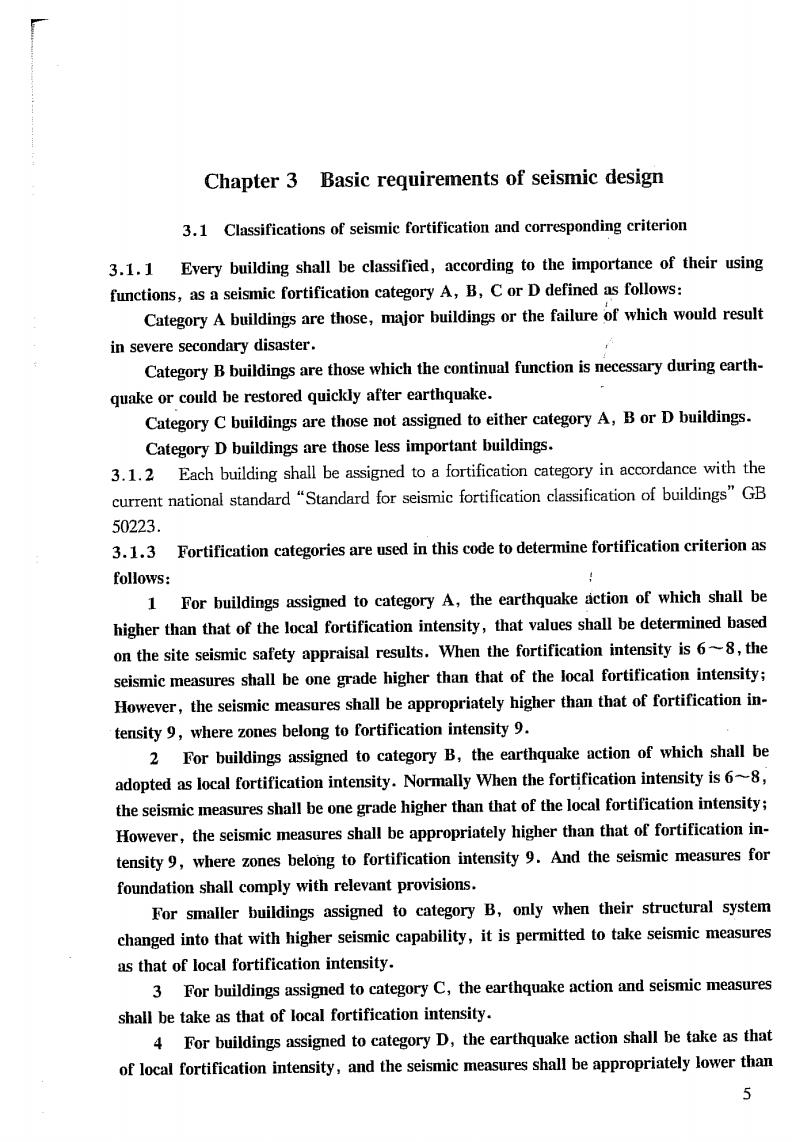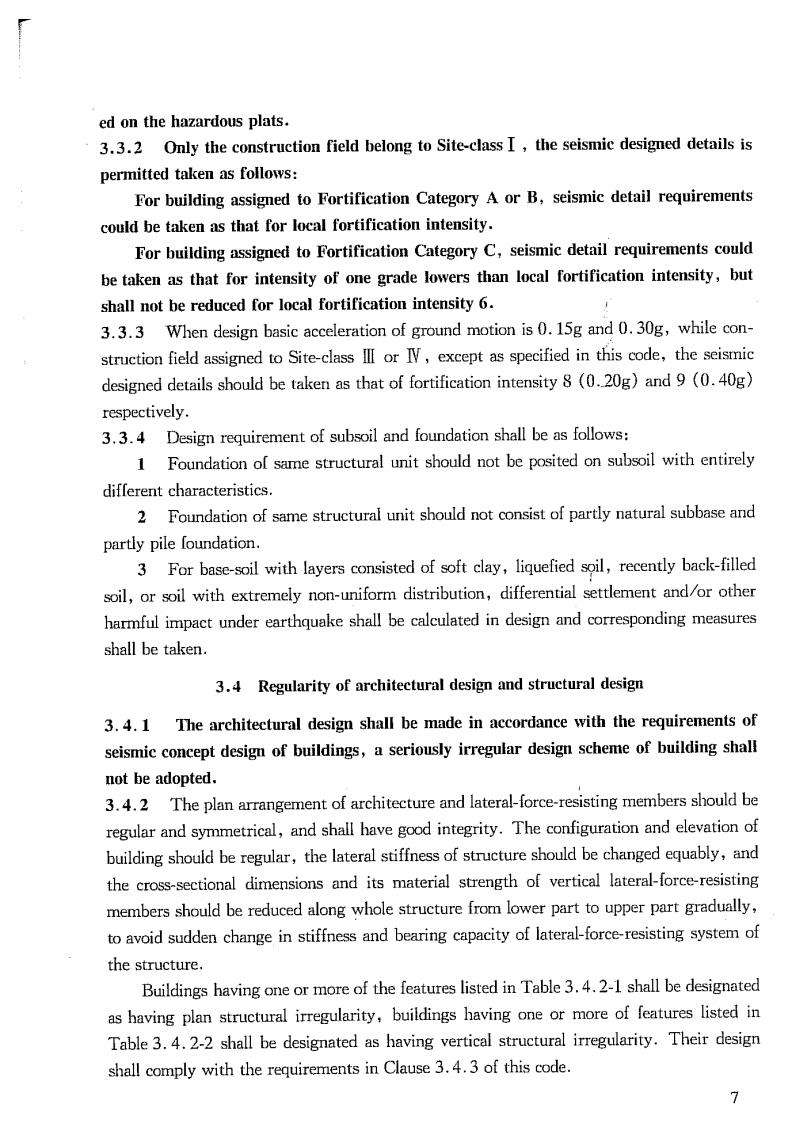
All of detailed requirements,which are determined according to seismic concept design of buildings and no calculation is necessary. 2.2 Main Notations 2.2.1 Actions and effects FEk,FEMk characteristic value of total horizontal and vertical seismic action of struc- ture respectively. GE,Gor -representative value of gravity load of structure(,or member)and the total equivalent gravity load of a structure in earthquake respectively. Wk -characteristic value of wind load. SE seismic effect bending moment,axial force,shear,stress and defor- mation). -base combination of seismic effect and other load effects. Sk- effect corresponding to characteristic value of action or load M -bending moment. -axial force. -shear. p compression on bottom of foundation. -lateral displacement. -rotation of story draft 2.2.2 Resistance and Material Properties K-stiffness of structure (or member). R -resistant capacity of structural member. f,fk,f design value,characteristic value and seismic design value of material strength (bearing capacity of subsoil included)respectively. -allowable rotation of story draft 2.2.3 Geometric Parameters A -cross-sectional area of structural member. A -cross-sectional area of reinforcement. B -total width of structure. H- total height of structure,or column height. L -total length of structure (or structural unit). -distance. as,as distance from near extreme fiber of section to the point for resultant of force of all longitudinal reinforcement in tension and compression respec- tively. b -width of cross section of member. 3

d -depth or thickness of soil,or diameter of reinforcement. h -height of story,or height of cross section of member i.e.depth of mem ber. 1 -length or span of member. t-thickness of seismic structural-wall or slab 2.2.4 Coefficients of Caleulation a -horizontal seismic influence coefficient. maximum value of horizontal seismic influence coefficient. mnx maximum value of vertical seismic influence coefficient. YG,YE,Yw- -partial factor of gravity,earthquake and wind load respectively. YRE -seismic adjusting factor for bearing capacity of member. -calculation factor. -amplification factor or adjusting factor of seismic effect (inner force or deformation). -slenderness ratio of member,or proportional factor. -yield strength coefficient of structure (or members). 0 -reinforcement ratio or ratio. -stability factor of compressive member. combination value coefficient,or effect factor 2.2.5 Others T -natural period of structure. N- penetration resistance (in blow number). LE -liquefaction index of subsoil under earthquake. mode coordinate of displacement (relative displacement of mass i-th of mode j-th in the z direction). Y mode coordinate of displacement (relative displacement of mass i-th of mode j-th in the y direction). -total number,such as number of stories,masses,reinforcement bars, spans etc -equivalent shear-wave velocity of soil. mode coordinate of rotation (relative rotation of mass i-th of mode j-th around the =axial direction). 4

Chapter 3 Basic requirements of seismic design 3.1 Classifications of seismic fortification and corresponding criterion 3.1.1 Every building shall be classified,according to the importance of their using functions,as a seismic fortification category A,B,Cor D defined as follows: Category A buildings are those,major buildings or the failure of which would result in severe secondary disaster. Category B buildings are those which the continual function is necessary during earth quake or could be restored quickly after earthquake. Category C buildings are those not assigned to either category A,B or D buildings. Category D buildings are those less important buildings. 3.1.2 Each building shall be assigned to a fortification category in accordance with the current national standard "Standard for seismic fortification classification of buildings"GB 50223. 3.1.3 Fortification categories are used in this code to determine fortification criterion as follows: 1 For buildings assigned to category A,the earthquake action of which shall be higher than that of the local fortification intensity,that values shall be determined based on the site seismic safety appraisal resultWhen the fortification intensity isth seismic measures shall be one grade higher than that of the local fortification intensity: However,the seismic measures shall be appropriately higher than that of fortification in- tensity 9,where zones belong to fortification intensity9. 2 For buildings assigned to category B,the earthquake action of which shall be adopted as local fortification intensity.Normally When the fortification intensity is68, the seismic measures shall be one grade higher than that of the local fortification intensity However,the seismic measures shall be appropriately higher than that of fortification in- tensity9,where zones belong to fortification intensity 9.And the seismic measures for foundation shall comply with relevant provisions. For smaller buildings assigned to category B,only when their structural system changed into that with higher seismic capability,it is permitted to take seismic measures as that of local fortification intensity. 3 For buildings assigned to category C,the earthquake action and seismic measures shall be take as that of local fortification intensity. 4 For buildings assigned to category D,the earthquake action shall be take as that of local fortification intensity,and the seismic measures shall be appropriately lower than 5

that of local fortification intensity.However,seismic measures cannot be lowered where zones belong to fortification intensity 6. 3.1.4 If the buildings assigned to fortification category B,Cand D are situated on zone where the fortification intensity is 6,except as specified in this code,earthquake action is permitted not to be calculated. 3.2 Seismic influences 3.2.1 The seismic influence for the buildings situated region shall be described by using the design basic acceleration of ground motion and design characteristic period of ground mo- tion,or by using the design ground motion parameters as indicated in Clause 1.0.5 of this code. 3.2.2 The corresponding relationship between the fortification intensity and the design basic acceleration of ground motion as indicated in Table 3.2.2.Where the design basic ac celeration of ground motion is0.15g and 0.30g,except as specified in this code,the seis- mic design of buildings shall be adopted as that of fortification intensity 7 and 8 respective ly. Table 3.2.2 Relationship between the intensity and design basicertiodmotion 6 7 8: 9 Dksgntbastcacedlemticnofgrourndnmotion 0.05g0.10(0.15g0.200.30g 0.40g Noegithe graviti 3.2.3 The design characteristic period of ground motion shall be determined according to the design earthquake groups and Site-classes of location of each building.For Site-class II, the design characteristic period of ground motion for 1st,2 nd,and 3rd design earthquake group shall be taken as 0.35s,0.40s and 0.45s respectively. Noe:Thecharacteristic perdogoundtionhererasriperi 3.2.4 The values of fortification intensity,design basic acceleration of ground motion and design earthquake groups for main cities and towns in China may be indicated in Appendix A of this code 3.3 Site and subsoil 3.3.1 When selecting a construction place,a comprehensive assessment classified as fa- vorable plat,unfavorable plat or hazardous plat to seismic fortification shall be made,ac- cording to seismicity of the region,and the geotechnical and geological data of site depen- dent to necessities of project.The favorable plats to seismic fortification shall be selected, while unfavorable plats shall be avoided except appropriate seismic measures have been taken.The buildings assigned to Fortification Category A,B and C.shall not be construct. 6

ed on the hazardous plats. 3.3.2 Only the construction field belong to Site-class I,the seismic designed details is permitted taken as follows: For building assigned to Fortification Category A or B,seismic detail requirements could be taken as that for local fortification intensity. For building assigned to Fortification Category C,seismic detail requirements could be taken as that for intensity of one grade lowers than local fortification intensity,but shall not be reduced for local fortification intensity 6. 3.3.3 When design basic acceleration of ground motion is 0.15g and 0.30g,while con- struction field assigned to Site-classI or IV,except as specified in this code,the seismic designed details should be taken as that of fortification intensity 8(0.20g)and 9(0.40g) respectively. 3.3.4 Design requirement of subsoil and foundation shall be as follows: 1 Foundation of same structural unit should not be posited on subsoil with entirely different characteristics 2 Foundation of same structural unit should not consist of partly natural subbase and partly pile foundation. 3For base-sil with ayer osd ofofyliqefed recently back-filled soil,or soil with extremely non-uniform distribution,differential settlement and/or other harmful impact under earthquake shall be calculated in design and corresponding measures shall be taken. 3.4 Regularity of architectural design and structural design 3.4.1 The architectural design shall be made in accordance with the requirements of seismic concept design of buildings,a seriously irregular design scheme of building shall not be adopted. 3.4.2 The plan arrangement of architecture and lateral-force-resisting members should be regular and symmetrical,and shall have good integrity.The configuration and elevation of building should be regular,the lateral stiffness of structure should be changed equably,and the cross-sectional dimensions and its material strength of vertical lateral-force-resisting members should be reduced along whole structure from lower part to upper part gradually, to avoid sudden change in stiffness and bearing capacity of lateral-force-resisting system of the structure. Buildings having one or more of the features listed in Table 3.4.2-1 shall be designated as having plan structural irregularity,buildings having one or more of features listed in Table 3.4.2-2 shall be designated as having vertical structural irregularity.Their design shall comply with the requirements in Clause 3.4.3 of this code